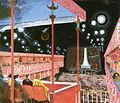Gunnar Asplund
Gunnar Asplund | |
|---|---|
Stockholm, Sweden | |
| Nationality | Swedish |
| Occupation | Architect |
| Buildings | Villa Sturegården, Nyköping, (1913), The Snellman House, Djursholm, (1918), Stockholm (1920) The Listers County Court House, Sölvesborg, (1921), The Skandia Cinema, Stockholm (1923), Stockholm Public Library, (1928), |
| Projects | Skogskyrkogården (1914-40), Gothenburg Courthouse Extension (1913-37) |
Erik Gunnar Asplund (22 September 1885 – 20 October 1940) was a
Major works
Among Asplund's most important works is the
Another important work is the extension of the Gothenburg City Hall Extension building which Asplund started on 1913 and finished 1937 - it shows his transformation from neo-classical to functionalist architect, a transformation in parallel with other European modernists like Erich Mendelsohn.
Asplund collaborated with architect
Gunnar Asplund is considered perhaps the most important modernist Swedish architect and has had a major influence on later generations of Swedish and Nordic architects.[5]
Our architectonic concept of space
The lecture "Our architectonic concept of space" was delivered in 1931 on the occasion of Asplund being appointed professor of architecture at the Royal Institute of Technology in Stockholm. Asplund published few theoretical texts. The lecture was later regarded as an important contribution to the attitudes of Asplund, as well as others of his generation, towards the architectural problems of the time. The lecture has its background in the then well known 2-volume book by German philosopher Oswald Spengler "The decline of the West" (1918 and 1922).[6]
Bibliography
- López Peláez, José Manuel (2002). La arquitectura de Gunnar Asplund. Barcelona, Fundación Caja de Arquitectos. ISBN 9788493254223.
Gallery
-
1922 sketch by Gunnar Asplund of the interior of the Skandia cinema, Stockholm
-
Stockholm Public Library
-
Gothenburg's City Hall Extension, interior
-
Skogskyrkogården cemetery
-
Listers County Court House, Sölvesborg
Exhibitions
- The Architecture of Gunnar Asplund, MoMA, New York (1978)
- En chantier: The Collections of the CCA, 1989-1999, Canadian Centre for Architecture, Montreal (1999-2000)
- Architecture and Design Drawings: Inaugural Installation, MoMA, New York (2004-2005)
- 75 Years of Architecture at MoMA, MoMA, New York (2007-2008)
- In Situ: Architecture and Landscape, MoMA, New York (2009-2010)
- Asplund Pavilion,Biennale of Architecture, Venice (2018-)
Notes
- ^ Gunnar Asplund, "Our architectonic concept of space", reproduced in "Swedish Grace: Modern classicism in Stockholm", International Architect, No. 8, vol. 1, Iss.8, 1982.
- )
- ^ Alvar Aalto Arkkitehti / Architect 1898-1976. Helsinki, Rakennustieto / Alvar Aalto Säätiö, 1998.
- ISBN 084780531X.
- ^ On Gunnar Asplund at the Swedish National Encyclopediae website (in Swedish, password needed)[permanent dead link]
- ^ Gunnar Asplund, "Our architectonic concept of space", reproduced in "Swedish Grace: Modern classicism in Stockholm", International Architect, No. 8, vol. 1, Iss.8, 1982, pp. 40-41.
External links
- Erik Gunnar Asplund Arkitekt. Online catalog of works and architecture map guide
- Website about Asplunds work on Stockholm Public Library
- Website with several photos about Asplunds work on Stockholm Public Library
- Further mentions/photos about his major masterpiece Stockholm Public Library
- Gunnar Asplund at the Museum of Modern Art
- Gunnar Asplund at DigitaltMuseum
- Finding aid for the Erik Gunnar Asplund collection, Canadian Centre for Architecture.
- Gunnar Asplund at Find a Grave





